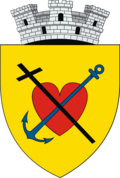Frasin (Suceava)
|
Frasin Frassin |
||||
|
||||
| Basic data | ||||
|---|---|---|---|---|
| State : |
|
|||
| Historical region : | Bucovina | |||
| Circle : | Suceava | |||
| Coordinates : | 47 ° 32 ' N , 25 ° 48' E | |||
| Time zone : | EET ( UTC +2) | |||
| Height : | 505 m | |||
| Area : | 87.31 km² | |||
| Residents : | 5,876 (October 20, 2011) | |||
| Population density : | 67 inhabitants per km² | |||
| Postal code : | 727245 | |||
| Telephone code : | (+40) 02 30 | |||
| License plate : | SV | |||
| Structure and administration (as of 2016) | ||||
| Community type : | city | |||
| Structure : | 3 districts / cadastral communities: Bucșoaia , Doroteia , Plutonița | |||
| Mayor : | Marinel Balan ( PSD ) | |||
| Postal address : | Str. Principală, no. 90 loc. Frasin, jud. Suceava, RO-727245 |
|||
| Website : | ||||
Frasin ( German Frassin ) is a small town in the Suceava district in Romania .
location
Frasin is located on the right bank of the Moldova River , between the Obcina Mare Mountains in the north and Stânișoara in the south. The district capital Suceava is about 40 km northeast.
history
In 1488 Ștefan cel Mare , the prince of the Vltava, bought a manor in the area of today's city and donated it to the Voroneț monastery . Frasin and its now incorporated villages were first mentioned in the years of the Russo-Turkish War (1768–1774) . Immediately afterwards Austria-Hungary took control of the Bukovina and thus also of Frasin. The land became the property of a church fund of the Orthodox Church. For a long time the place was very remote; the residents were mainly engaged in animal husbandry. After the opening of the Dărmăneşti – Câmpulung Moldovenesc railway through the Vltava valley in 1888, the extraction and processing of wood developed. The charcoal burning plant was also able to benefit from the transport links. In 1898 the first modern wood processing factory was built by the Jewish entrepreneur Adolf Löwy.
In the course of the economic development, members of other nationalities, mainly Germans, Jews and Poles , moved to the place, which had been inhabited mainly by Romanians . In 1890 261 Jews were registered in Frasin.
During the First World War , the front line between Austro-Hungarian and Russian troops temporarily ran near Frasin. After the war, Bukovina became part of Romania. The majority of the Bukowina Germans left Frasin in 1940. In 2004 the place was declared a city.
The most important branches of industry are agriculture, wood processing, the construction industry and the extraction of natural gas.
population
In 1930 there were around 3350 residents in the area of today's city, including around 1900 Romanians, 1100 Germans , 150 Jews and Roma each, and 50 Poles. The 2002 census counted 5702 inhabitants, including 5664 Romanians and 36 Germans.
traffic
Frasin is on the Dărmăneşti – Câmpulung Moldovenesc railway line . Both local and express trains stop at the city's train station. There are direct connections to many of the country's larger cities, including Bucharest , Cluj-Napoca , Timișoara and Suceava . Several times a day there are buses to Suceava, Gura Humorului , Vatra Dornei and Câmpulung Moldovenesc . The national road Drum național 17 runs through the city from Dej to Suceava.
Attractions
- Voroneț Monastery (7 km away)
Web links
Individual evidence
- ↑ 2011 census in Romania at citypopulation.de
- ^ Website of the city
- ^ Map of the 1930 census
- ↑ Census - ( page no longer available , search in web archives: privind rezultatele provizorii ale Recensământului Populaţiei şi Locuinţelor - 2011 ) (PDF).


